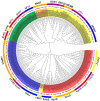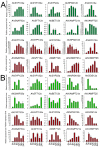Genome-Wide Analysis of the SNARE Family in Cultivated Peanut (Arachis hypogaea L.) Reveals That Some Members Are Involved in Stress Responses
- PMID: 37108265
- PMCID: PMC10139436
- DOI: 10.3390/ijms24087103
Genome-Wide Analysis of the SNARE Family in Cultivated Peanut (Arachis hypogaea L.) Reveals That Some Members Are Involved in Stress Responses
Abstract
The superfamily of soluble N-ethylmaleimide-sensitive factor attachment protein receptor (SNARE) proteins mediates membrane fusion during vesicular transport between endosomes and the plasma membrane in eukaryotic cells, playing a vital role in plant development and responses to biotic and abiotic stresses. Peanut (Arachis hypogaea L.) is a major oilseed crop worldwide that produces pods below ground, which is rare in flowering plants. To date, however, there has been no systematic study of SNARE family proteins in peanut. In this study, we identified 129 putative SNARE genes from cultivated peanut (A. hypogaea) and 127 from wild peanut (63 from Arachis duranensis, 64 from Arachis ipaensis). We sorted the encoded proteins into five subgroups (Qa-, Qb-, Qc-, Qb+c- and R-SNARE) based on their phylogenetic relationships with Arabidopsis SNAREs. The genes were unevenly distributed on all 20 chromosomes, exhibiting a high rate of homolog retention from their two ancestors. We identified cis-acting elements associated with development, biotic and abiotic stresses in the promoters of peanut SNARE genes. Transcriptomic data showed that expression of SNARE genes is tissue-specific and stress inducible. We hypothesize that AhVTI13b plays an important role in the storage of lipid proteins, while AhSYP122a, AhSNAP33a and AhVAMP721a might play an important role in development and stress responses. Furthermore, we showed that three AhSNARE genes (AhSYP122a, AhSNAP33a and AhVAMP721) enhance cold and NaCl tolerance in yeast (Saccharomyces cerevisiae), especially AhSNAP33a. This systematic study provides valuable information about the functional characteristics of AhSNARE genes in the development and regulation of abiotic stress responses in peanut.
Keywords: SNARE; gene family; peanut; stress; vesicular transport.
Conflict of interest statement
The authors declare no conflict of interest.
Figures








Similar articles
-
Genome-wide identification, evolutionary and expression analysis of the cyclin-dependent kinase gene family in peanut.BMC Plant Biol. 2023 Jan 19;23(1):43. doi: 10.1186/s12870-023-04045-w. BMC Plant Biol. 2023. PMID: 36658501 Free PMC article.
-
Molecular and transcriptional characterization of phosphatidyl ethanolamine-binding proteins in wild peanuts Arachis duranensis and Arachis ipaensis.BMC Plant Biol. 2019 Nov 9;19(1):484. doi: 10.1186/s12870-019-2113-3. BMC Plant Biol. 2019. PMID: 31706291 Free PMC article.
-
Comprehensive genomic characterization of NAC transcription factor family and their response to salt and drought stress in peanut.BMC Plant Biol. 2020 Oct 2;20(1):454. doi: 10.1186/s12870-020-02678-9. BMC Plant Biol. 2020. PMID: 33008287 Free PMC article.
-
The genus Arachis: an excellent resource for studies on differential gene expression for stress tolerance.Front Plant Sci. 2023 Oct 30;14:1275854. doi: 10.3389/fpls.2023.1275854. eCollection 2023. Front Plant Sci. 2023. PMID: 38023864 Free PMC article. Review.
-
WRKY transcription factors in Arachis hypogaea and its donors: From identification to function prediction.Plant Physiol Biochem. 2023 Nov;204:108131. doi: 10.1016/j.plaphy.2023.108131. Epub 2023 Oct 26. Plant Physiol Biochem. 2023. PMID: 37897893 Review.
References
MeSH terms
Substances
Grants and funding
LinkOut - more resources
Full Text Sources

